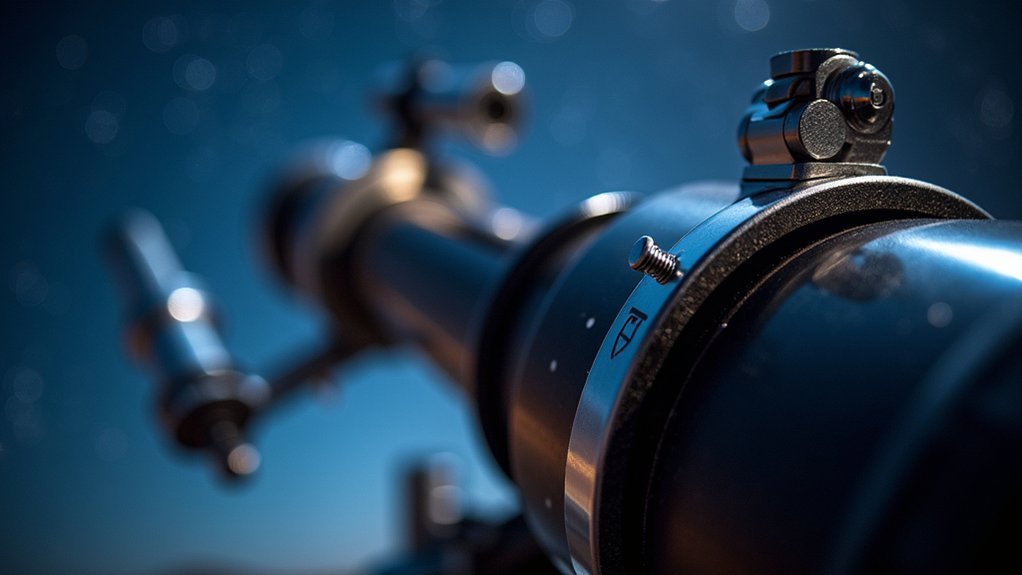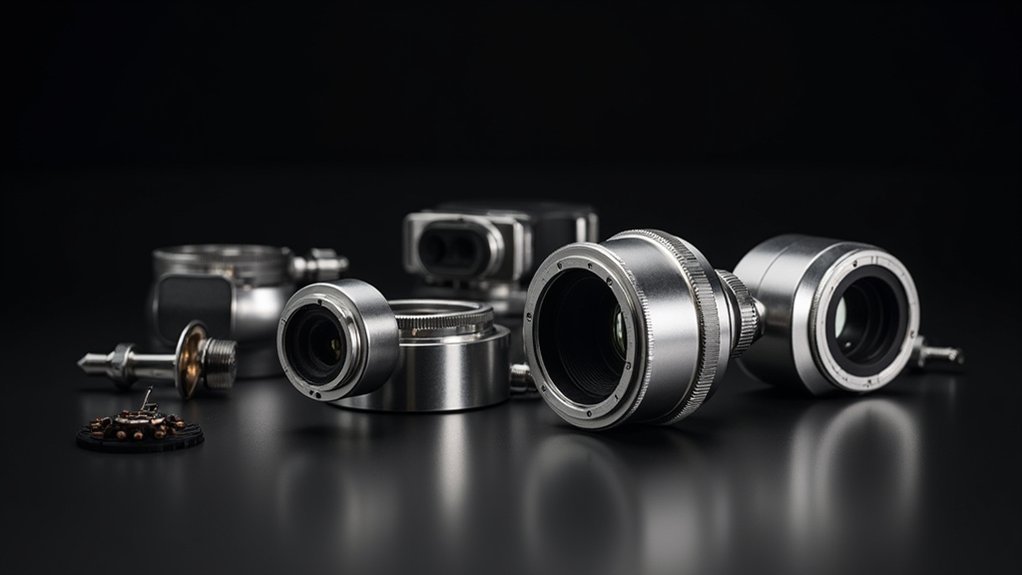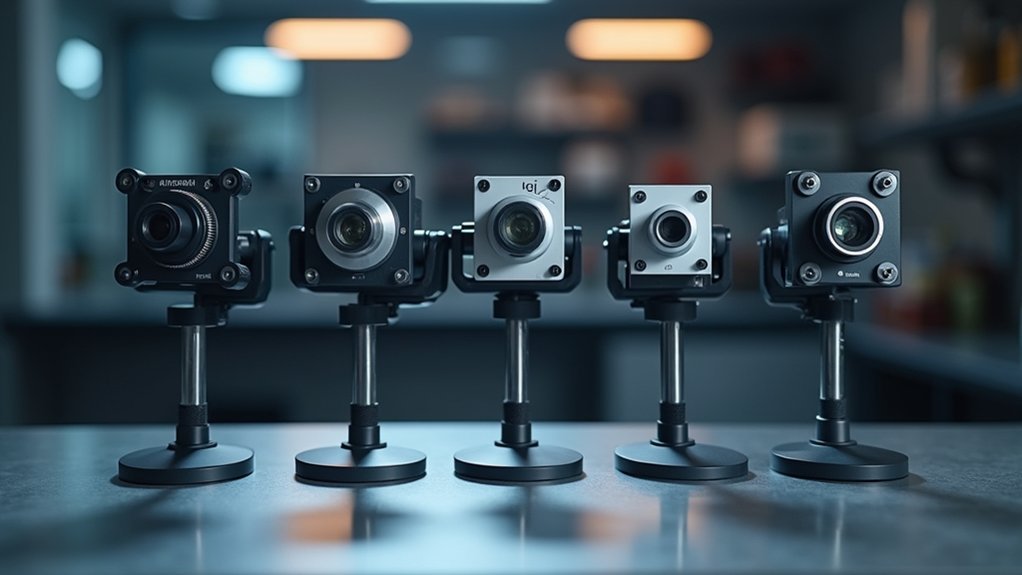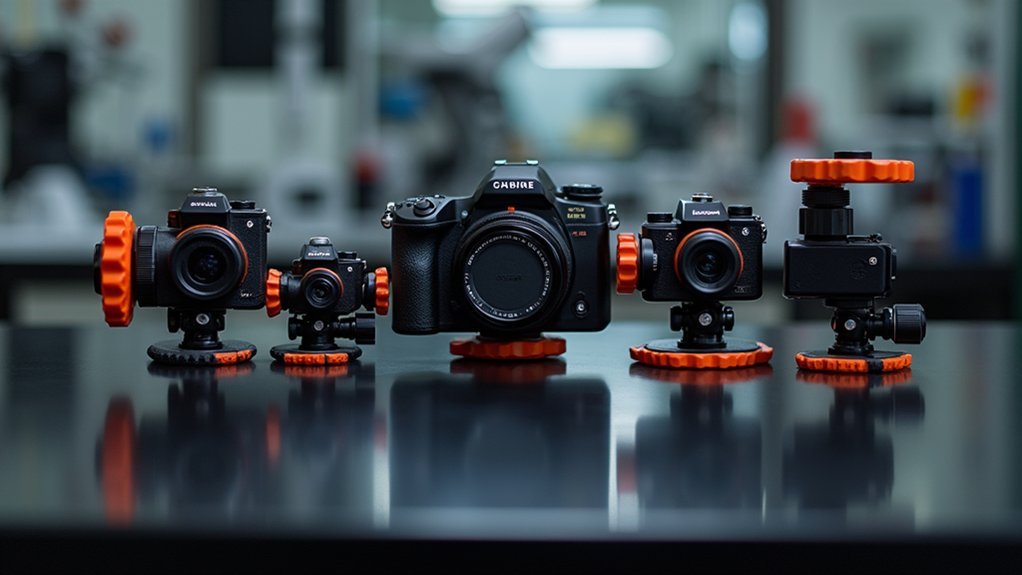The top five mounting systems for scientific imaging include Prime Focus mounts that maximize light transmission, C-Mount adapters with standardized dimensions, versatile T-Mount systems for cross-compatibility, Trinocular Port solutions providing dedicated camera pathways, and Camera-Sensor matching techniques for ideal resolution. You’ll achieve clearer images and prevent vignetting with these systems. Each mounting solution offers unique advantages for specific scientific applications, with proper alignment being the key to capturing the full field of view.
Prime Focus Mounting Systems: Enhanced Optical Pathways

When selecting an imaging system for scientific applications, Prime Focus mounting systems stand out as exceptional solutions for researchers seeking maximum image quality.
These systems replace the microscope eyepiece with your camera, creating a direct light path that maximizes transmission and enhances resolution.
Direct camera-to-microscope attachment creates unobstructed light paths that enhance image clarity and boost overall resolution.
You’ll find that proper alignment between your camera sensor and the optical path is critical with this mount type. By positioning your camera directly in the prime focus, you’ll avoid vignetting while ensuring precisely focused images for research documentation.
This mounting approach works particularly well with DSLR cameras that have larger sensors. The simplified optical configuration eliminates additional lenses that might otherwise reduce image quality.
You’ll appreciate the streamlined workflow and straightforward adjustments that make scientific imaging more efficient and produce clearer, more detailed results.
C-Mount Adapters: Universal Standards for Digital Microscopy
While numerous mounting options exist for scientific imaging, C-mount adapters have emerged as the industry standard for digital microscopy applications. Their 25.5mm diameter and precise 17.52mm flange focal distance guarantee compatibility with most scientific cameras, optimizing your microscope imaging capabilities.
You’ll achieve maximum field of view when your camera sensor size aligns perfectly with C-mount specifications, preventing vignetting and light loss. These adapters eliminate the need for additional optics, maintaining optical path integrity for superior results.
Proper alignment between your camera sensor and the circular photo port is vital for clear imaging. By utilizing C-mount adapters, you’re equipped to document specimens with exceptional quality, making these standardized components essential tools for researchers seeking reliable, high-resolution scientific photography in laboratory settings.
T-Mount Systems: Cross-Compatibility and Imaging Flexibility

Unlike their C-mount counterparts, T-mount systems offer exceptional versatility through their standardized M42x0.75 thread design.
You’ll appreciate how this architecture enables cross-compatibility between various camera brands and microscope models, providing remarkable imaging flexibility for your scientific photography needs.
The two-component design—consisting of a T-adapter that connects to your microscope and a T-ring for your camera—allows for quick assembly and complete manual control over imaging parameters.
This setup is particularly valuable when you’re connecting telescopes or microscopes to different cameras.
For ideal image quality, verify proper alignment of your T-mount components.
This careful positioning prevents vignetting and guarantees full field coverage in your final images—critical considerations for precision-focused scientific documentation where every detail matters.
Trinocular Port Integration: Dedicated Camera Mounting Solutions
Because scientific imaging often requires simultaneous viewing and documentation, trinocular ports have become essential components in advanced microscopy setups. These specialized ports create a dedicated optical pathway for camera integration while maintaining the microscope’s full optical performance for direct observation.
When integrating cameras into your microscopy workflow, you’ll need to select appropriate SLR or C-mount adapters that match both your camera and microscope specifications. This compatibility guarantees superior image quality and proper alignment.
The adjustable diopters in trinocular mounts allow you to fine-tune focus, accommodating variations in eyesight or sensor positioning.
Precise focus calibration with adjustable diopters ensures perfect clarity for both visual observation and digital imaging.
A key advantage of trinocular ports is their ability to prevent light loss and vignetting, making sure your camera captures the microscope’s complete field of view—critical for accurate scientific imaging and detailed specimen analysis.
Advanced Camera-Sensor Matching Techniques for Optimal Resolution

To achieve exceptional microscopic imagery, matching your camera sensor specifications with the microscope’s optical properties remains fundamental to scientific imaging success.
When integrating cameras into your imaging systems, proper alignment prevents uneven illumination and maximizes resolution.
C-mount specifications require precise adherence to the 25.5mm diameter and 17.52mm flange distance to avoid vignetting.
Consider these advanced matching techniques:
- Sensor sizes should correspond with your microscope camera’s circular photo port for complete field coverage.
- Focal length optimization to guarantee light properly reaches all sensor areas.
- Regular position testing to eliminate dark corners and shadows.
- Additional optical components like relay lenses to enhance resolution when necessary.
Frequently Asked Questions
How Often Should Mounting Systems Be Recalibrated?
You should recalibrate mounting systems every 3-6 months, depending on usage frequency and precision requirements. If you’re experiencing alignment issues or after moving equipment, don’t wait—recalibrate immediately for accurate results.
Are Mounting Systems Compatible With Cryogenic Imaging Environments?
Yes, you’ll find specialized mounting systems designed for cryogenic imaging. They’re made with thermal-resistant materials and minimal thermal expansion properties. Always check compatibility ratings as standard mounts may fail in extreme cold environments.
What Tools Are Required for Mounting System Installation?
You’ll need basic tools like screwdrivers, wrenches, Allen keys, and a level for mounting system installation. For precision setups, you might also require micrometers, torque drivers, and vibration-dampening equipment.
Do Vibration-Dampening Systems Affect Image Quality?
Yes, vibration-dampening systems greatly improve your image quality by eliminating blur and distortion caused by environmental vibrations. You’ll notice sharper details and better resolution, especially during long exposures or high-magnification imaging.
Can Mounting Systems Be Used With Custom-Built Imaging Platforms?
Yes, you can adapt most mounting systems to work with custom-built imaging platforms. You’ll need to verify compatibility with interface plates, mounting points, and load requirements for your specific setup.
In Summary
You’ve now explored the top scientific imaging mounting systems available to researchers. Whether you’re using prime focus for astronomical work or C-mounts for microscopy, you’ll find these systems enhance your imaging capabilities greatly. Remember that matching your camera sensor to your optical system isn’t just good practice—it’s essential for capturing the high-resolution data your research demands. Choose wisely to maximize your imaging potential.





Leave a Reply